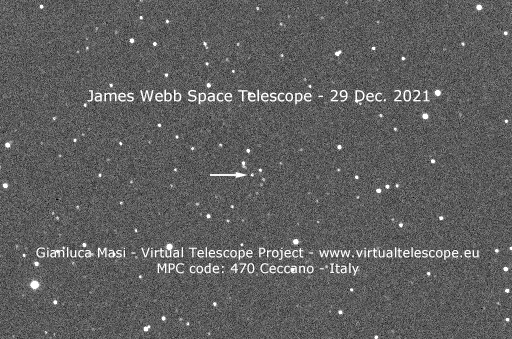Skywatcher spots James Webb Space Telescope from Earth in telescope photos
Watch as the most powerful space telescope ever built drifts ever farther from Earth.

Thanks to images from a robotic Earth telescope, you can now watch NASA's James Webb Space Telescope travel through the final frontier.
The James Webb Space Telescope, a collaborative effort decades in the making involving NASA, the European Space Agency and the Canadian Space Agency, launched in the early hours of Dec. 25. Four days later, on Dec. 29, astrophysicist Gianluca Masi of the Virtual Telescope Project spotted Webb traveling through space using a robotic telescope.
Masi combined some of his imagery into a short movie of Webb in action that you can watch above. You can spot Webb in the image and video as a small white dot with the help of a tiny arrow. (You can additionally follow along with the mission's milestones at a NASA website here.)
Live updates: NASA's James Webb Space Telescope mission
In photos: The Christmas launch of NASA's James Webb Space Telescope

Masi's video shows Webb in space, on its way to its final destination, a gravitationally stable point in space called L2, or the Earth-sun Lagrange point 2, about 1 million miles (1.5 million km) from Earth.
At the time, the observatory was about 340,000 miles (550,000 kilometers) from Earth, Masi wrote. That's about 100,000 miles (160,000 km) beyond the moon's orbit.
To snap the "movie" of Webb, the robotic telescope tracked Webb's motion across the sky. Masi collected this imagery of Webb using a single 120-second exposure with the PlaneWave 17"+Paramount ME+SEBIG STL-6303E robotic telescope, nicknamed "Elena," that is available at the Virtual Telescope Project in Ceccano, Italy.
Get the Space.com Newsletter
Breaking space news, the latest updates on rocket launches, skywatching events and more!
At the same time that Masi was collecting these observations, Webb extended its deployable tower assembly (DTA), a step that gave the telescope the space to begin deploying its massive sunshield, according to the Virtual Telescope Project.
If you're looking to get into photographing the night sky, check out our best cameras for astrophotography and best lenses for astrophotography. Our best telescopes guide can help you select the best observing tool for you.
Email Chelsea Gohd at cgohd@space.com or follow her on Twitter @chelsea_gohd. Follow us on Twitter @Spacedotcom and on Facebook.
Join our Space Forums to keep talking space on the latest missions, night sky and more! And if you have a news tip, correction or comment, let us know at: community@space.com.

Chelsea “Foxanne” Gohd joined Space.com in 2018 and is now a Senior Writer, writing about everything from climate change to planetary science and human spaceflight in both articles and on-camera in videos. With a degree in Public Health and biological sciences, Chelsea has written and worked for institutions including the American Museum of Natural History, Scientific American, Discover Magazine Blog, Astronomy Magazine and Live Science. When not writing, editing or filming something space-y, Chelsea "Foxanne" Gohd is writing music and performing as Foxanne, even launching a song to space in 2021 with Inspiration4. You can follow her on Twitter @chelsea_gohd and @foxannemusic.









